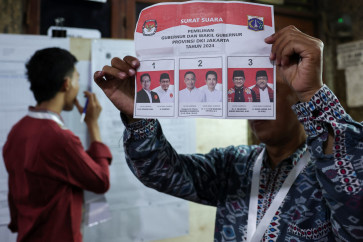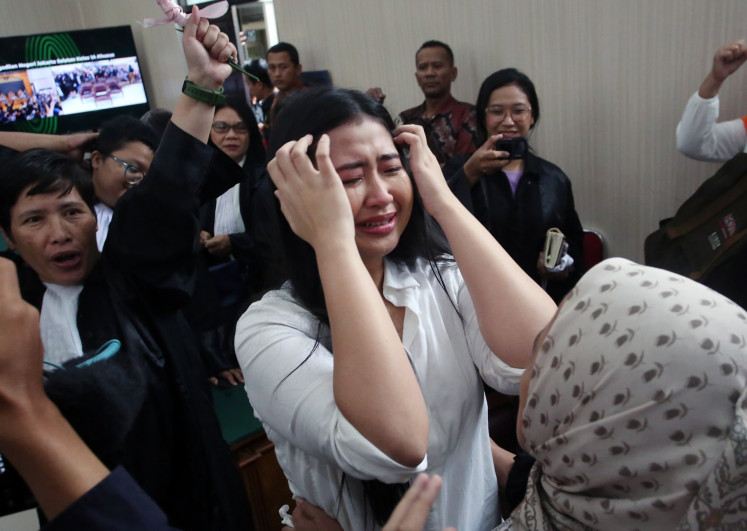Popular Reads
Top Results
Can't find what you're looking for?
View all search resultsPopular Reads
Top Results
Can't find what you're looking for?
View all search resultsExhibition explores visual arts in Indonesian literature
The “Seeing Words” book design exhibition, curated by Zinnia Nizar, explores visual art’s ongoing engagement and entanglement with book writing, demonstrating that the complexity of language in its ability to inform and confound people appeals to artists and graphic designers
Change text size
Gift Premium Articles
to Anyone
T
he “Seeing Words” book design exhibition, curated by Zinnia Nizar, explores visual art’s ongoing engagement and entanglement with book writing, demonstrating that the complexity of language in its ability to inform and confound people appeals to artists and graphic designers.
Exhibition director Emir Hakim said the exhibition was organized in line with the introduction of THE ARTS+ by the Frankfurt Book Fair, the world’s oldest and biggest, for the first time this year.
THE ARTS+, which runs until Sunday, like the fair, aims to offer an ideal context for discussing digitization as an opportunity and for launching new business models in the creative industries, while establishing itself at the interface between cultural industries and the technology sectors.
Emir said “Seeing Words” examined the importance of the visual-textual relationship that became prominent with the rise of literature within the publishing industry.
The exhibition, jointly held by the National Book Committee and the Indonesian Graphic Designers Association, offers interpretations of Indonesian classics, like Siti Nurbaya by Marah Rusli and Shackles by Armijn Pane, and contemporary award-winning novels, like Man Tiger by Eka Kurniawan and The Question of Red by Laksmi Pamuntjak.
Each book selected by the book committee for the exhibition was interpreted by one of 10 design firms or studios. The work took about four months to finish.
In the process, they explored the limitations of language while embracing questions of politics, sex, identity, race and idealism.
“We take this job as a challenge,” Emir said. “We want to internationally show off the great level of
our design.”
Designers Ismiaji Cahyoto, Matthew Christopher and Glory Amadea of SunVisual offered their version of The Weaverbirds by YB Mangunwijaya, which centers on the romance between Teto and Atik set during the country’s revolution and the rise of the republic.
The designers explained in the catalog that the book contrasted the ideologies of the characters with their political backdrop. They said the story was actually a metaphor of the natural courtship of weaverbirds and therefore the visualization mirrored that.
“The words taken from the book and from the social, cultural and political tensions gradually construct a nest — visually, where Teto builds to court Atik. The assembly of the nest takes twists and turns, like the journey taken in each of the characters’ lives, where romance builds but is suppressed platonically.”
Designers Jefferson Edri and Kristin Monica of Feat Studio were inspired by the story and events depicted in Ayu Utami’s novel Saman. They said they felt the best way to represent the novel’s complex structure and all the points of view was to present it as an investigation — in this case a missing person investigation.
“We treat each chapter of the novel as a trail of evidence that when combined together becomes a case document, which will act as a visual companion to enhance the reading experience.”
Eka’s novel was transformed by designers Andrew Budiman, Ari Kurniawan, Ellena Ekarahendy and Kathleen Azali from the Surabaya-based Butawarna Design Co-op into an evocative and informative visual guide book entitled Becoming Tiger Man — with the cover illustrating the book’s lead character Margio halfway through transforming from a man into a tiger when jumping into a circus-like fire ring.
Eka, who is one of the prominent Indonesian writers invited to the fair, said he was usually involved in the discussions on creating the covers of his books and at times, when he is in good spirits, he would create them himself.
“It’s different,” he said after observing the visual interpretation of his book on display at the exhibition, aware that the cover was inspired by a scene in his story.
“[The designers] have a different visual interpretation, which is okay,” said Eka. “Several covers for my foreign edition books are also different.”










